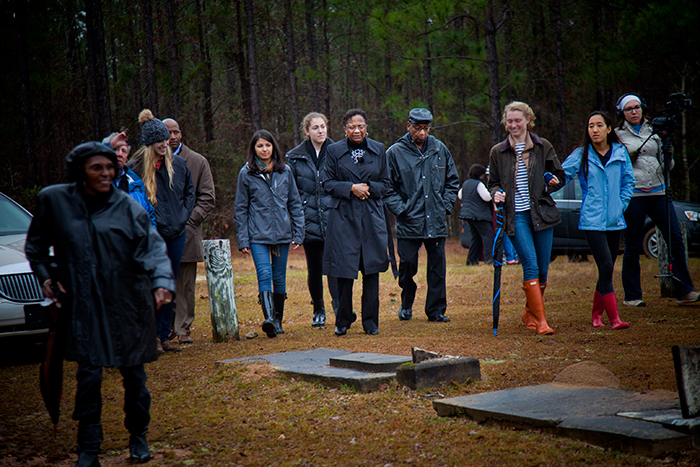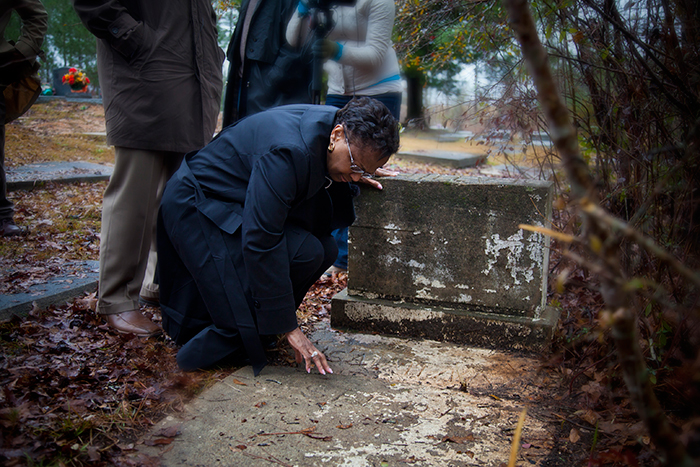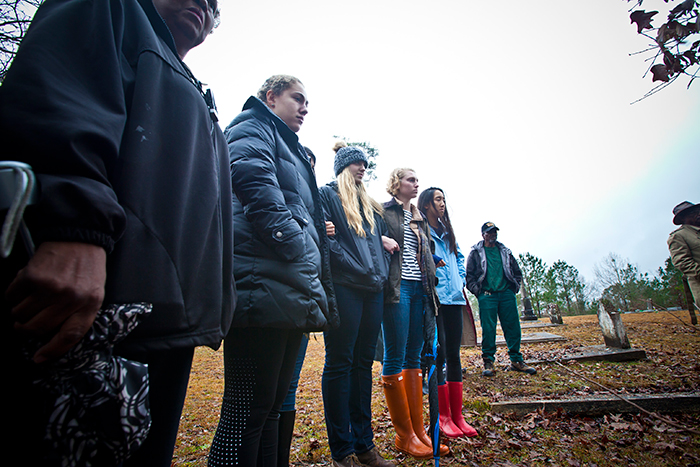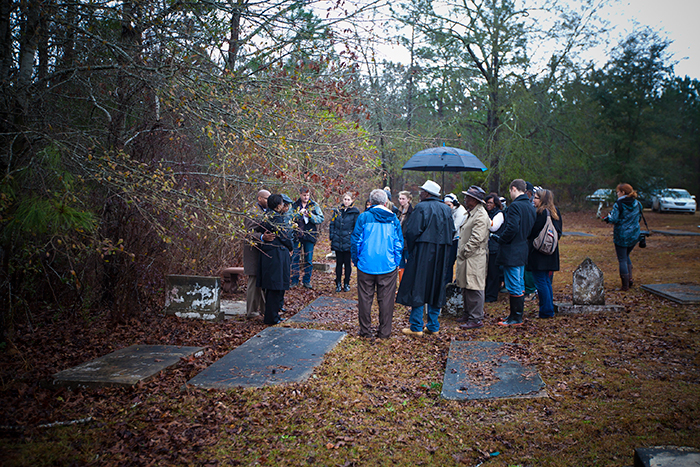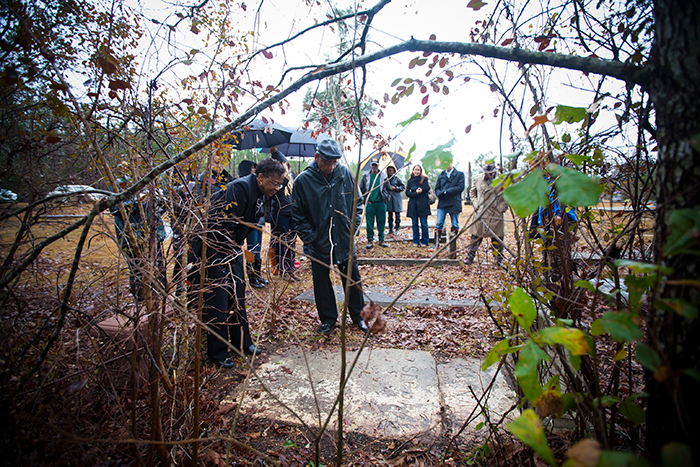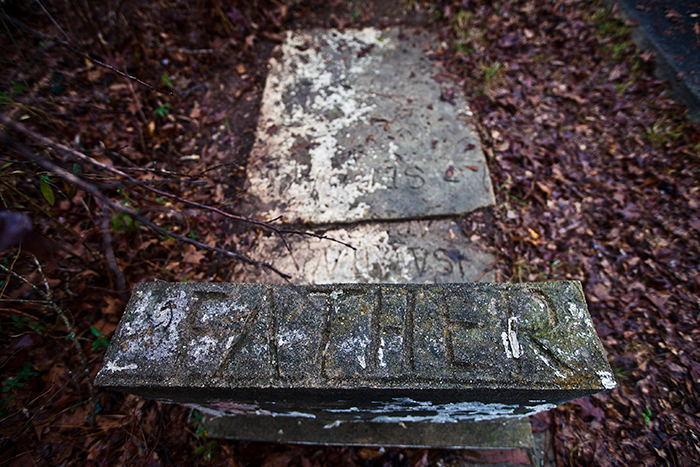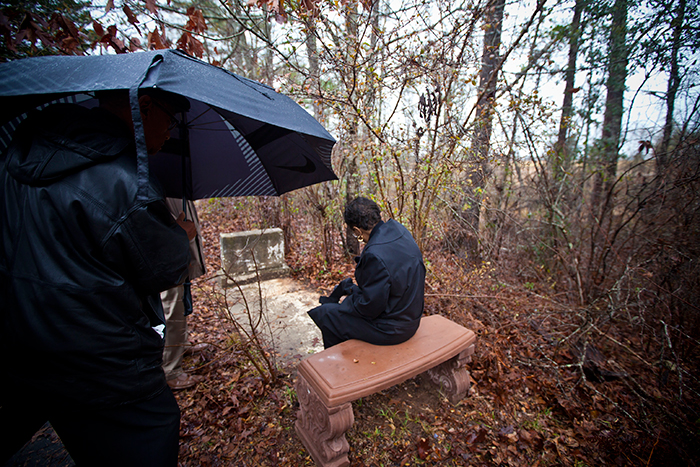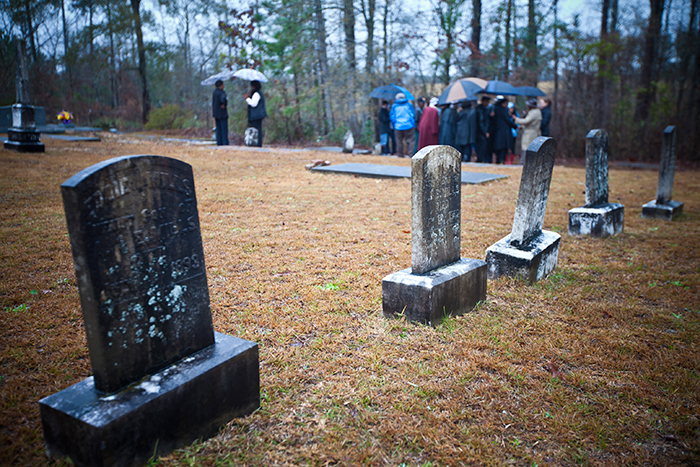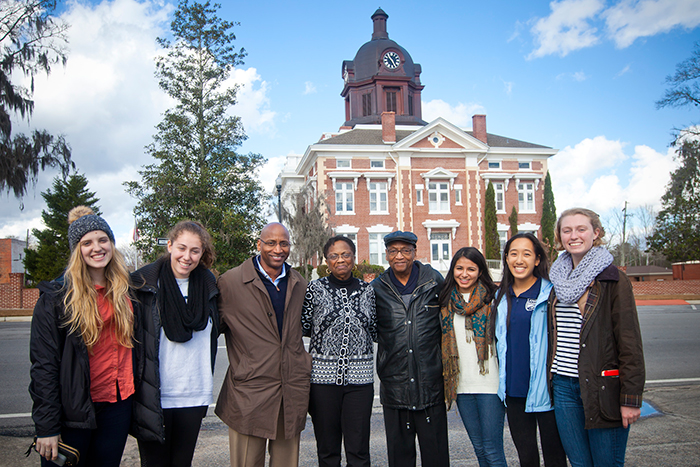Arms linked, five Emory University students stood silently in the muddy cemetery, their cheeks damp with rain and tears. It was a moment none could have imagined when they signed up for a class focused on the Georgia Civil Rights Cold Cases Project — a moment set in motion by an act of bravery almost 70 years ago, brought full circle now through research, determination and what more than one person called a "miracle."
With the students bearing witness under the gray Georgia sky, Dorothy Nixon Williams rested her hand on a rough concrete headstone etched with the word "Father," bent to touch the concrete slab beneath it, then wept in the arms of her son.
"Father." Her father, Isaiah Nixon, an African American man who had dared to vote in the 1948 Democratic Primary in Montgomery County, Georgia, only the second held since the U.S. Supreme Court ruled all-white primaries unconstitutional. Her father, who was gunned down by two white men that evening on the front porch of her home, when she was just six years old.
Her father, whose grave had been lost in the rural cemetery after Williams, her mother and five siblings fled to Jacksonville, Florida, shortly after his death.
Her father, whose grave had been found by those Emory students.
The gathering wasn't a funeral, but their professor, Hank Klibanoff, offered a eulogy of sorts as Williams, her husband and son, the students and a few local residents — mostly relatives of others who had voted on that fateful day — stood together in the neatly kept graveyard ringed with pines.
"I don't know anyone who is not moved by the story of Isaiah Nixon, and it is because Isaiah Nixon matters," Klibanoff said. "His life matters, his death matters, his disappearance from history matters. And what matters more is that he has now reappeared, and I just think that is miraculous in so many ways."
He read a passage from the biblical book of Isaiah — "By oppression and judgment he was taken away, yet who of his generation protested? For he was cut off from the land of the living, for the transgression of my people he was punished …" — as some in the group murmured along.
"At that time in our history, an act of voting was an act of protest," Klibanoff said. "It was a right that was deprived him, and he paid the price for voting, and that is something I think we are all resolved to never let happen again."
Williams' son spoke briefly before his mother, now 73, addressed the students: "Your faces will always be in my mind," she said.
"When you first called me I still had a lot of anger, and I think I told you all I did, but after talking to your group, some of that was released," Williams continued. "And I want to let you know now, the anger is completely released, and thank you all for that. I can just resolve this. It's been settled. …
"I can't say any more, except all that is coming in my mind is thank you, thank you, thank you."
Long road to discovery, closure
The road to the grave's discovery and Williams' closure began long before Klibanoff and the students boarded a rented van on Jan. 22 and left Atlanta before dawn for the approximately 180-mile trek to Old Salem Cemetery.
The Georgia Civil Rights Cold Cases Project launched at Emory in the fall of 2011, directed and taught by Klibanoff, a Pulitzer-prize winning journalist and James M. Cox Professor of Journalism at Emory, and Brett Gadsden, associate professor of African American studies. The undergraduate class is cross-listed in history, journalism, African-American studies and American studies, and will soon be listed through creative writing, illustrating the interdisciplinary approaches both professors and students bring to the cases they examine.
Each semester, students take an in-depth look at one case, exploring primary evidence ranging from FBI records and court transcripts to personal archives and contemporaneous media accounts. Unlike some similar projects, their goal is not necessarily to "solve" the cases — in many, the killers are well-known — but to better understand the context in which racially motivated murders went unpunished in the Jim Crow South.
Isaiah Nixon was shot on Sept. 8, 1948 and died two days later in a hospital in neighboring Laurens County. The white brothers who killed him, Jim A. Johnson and Johnnie Johnson, were arrested and charged with murder and accessory to murder, respectively, according to the Cold Cases Project.
The duo claimed they had gone to Nixon's house to hire him for work, then shot him in self-defense, although the white sheriff said they killed him for voting. The case drew attention from the NAACP, the FBI and the national press, but Jim Johnson was easily acquitted by the all-white jury, and charges against his brother were dropped.
Klibanoff said he and Gadsden chose Nixon's case as the focus of the Fall 2015 course based on its importance and the many themes it invoked, including the history of all-white primaries and all-white juries in Georgia, the struggle for voting rights, and the involvement of the NAACP, among many others.
"It had enough angles that a class full of students could take it on," he said.
Klibanoff secured access to 235 pages of previously unreleased FBI files and Nixon's death certificate, and students dug in. They constructed an intricate timeline of events and strove to understand the relationships among key players in the case.
Lucy Baker, a sophomore from San Francisco, spent her own time outside of class to make trips to the archives of the University of Georgia in Athens and the Georgia Archives in Morrow in search of clues. Her research led to the discovery that Nixon's killers and the sheriff-elect at the time of his death were first cousins.
Then came the biggest discovery of all.
An unexpected find
Baker and classmates Ellie Studdard, a junior from Atlanta, and Emily Gaines, a senior from New York City, felt drawn to actually see the places they were studying in such detail. In November, they decided to take a road trip to the area where Isaiah Nixon lived and died.
One day after class, they mentioned their idea to Klibanoff. "Can I go with you?" they recalled him asking. "I'll drive."
The sun was shining on that first trip. The students visited the tiny public library in Mt. Vernon, then the Montgomery County Courthouse. There they met James Harris, whose father had also voted in the 1948 primary — despite being told by the sheriff-elect to stay home, a message his family has never known whether to interpret as a warning or a threat.
Harris takes care of Old Salem Cemetery, just south of Mt. Vernon near Uvalda, Georgia, where Nixon was believed to be buried, but where his grave could not be found. Another group that examined the case, the Civil Rights and Restorative Justice Project at Northeastern University School of Law, had helped place a concrete bench there in his honor, although it did not bear his name. Harris offered to show the students the cemetery and his own father's resting place.
But as Klibanoff and the other students walked with Harris through the cemetery, Studdard drifted away from the group. She had grown up visiting cemeteries with her father, making rubbings of the headstones of family graves, and she began walking up and down each row.
She reached the end of a line, where the grass gives way to fallen leaves, pine needles, bushes and trees. Then she noticed a bit of concrete showing through, similar to the slabs that marked other graves from the 1930s and 1940s, with names written with a finger or stick before the cement dried so long ago.
Looking closely, she could see part of a word, starting with "I." Quickly she brushed more dirt and leaves away. The beginnings of "September," the month of Isaiah Nixon's death, appeared. Heart racing, she scraped away more leaves, more dirt, wanting to be sure.
She hurried back to the group with muddied hands, bringing a part of the story they had never expected to, quite literally, uncover.
"I found it."
"It was like a miracle"
The group rushed back to the concrete slab at the edge of the cemetery and did their best to clean the grave. Though cracked, its inscription was now clear: Isaiah Nixon, with the dates of his birth and death, April 3, 1920, and Sept. 10, 1948. The once-hidden slab adjoined a headstone bearing that single word: "Father."
They grabbed a smartphone and contacted Dorothy Williams, who still lived in Jacksonville, but had flown up to Emory earlier in the fall to visit their class. They showed her the grave via video. Later, she invited them to come to Old Salem Cemetery in January, to be with her when she saw it for the first time since she attended his funeral 67 years ago.
So on Jan. 22, as most Emory students either slept or anxiously awaited word on whether the university would close early due to expected snow, Studdard, Baker, Gaines and two other classmates — Emily Li, a junior from Charleston, and Sarah Husain, a senior from Chicago — met Klibanoff in the dark morning rain for the more than three-hour drive back to cemetery.
Their goal was to get to the cemetery early, to be there when Williams and her family arrived from Florida. But with the dirt road to the cemetery washed out, their first reunion occurred on the roadside by the old Uvalda Police Department, as they waited to learn if there was another route.
Climbing out of the van, Studdard approached Williams as she sat in the backseat of her car, and was quickly embraced.
"Oh, Ellie, you did something else that no one else could," Williams told her. "That name, 'Ellie,' just rings in my mind, and all I hear is, 'I found it.'"
Shortly before Harris returned to lead the caravan down another dirt road to the cemetery, Williams explained in an interview how she felt when she got that first call.
"I was just stunned. I was in awe. It was disbelief, although in reality, I knew they had to be telling the truth," she said. "That was amazing. It was like a miracle.
"For Ellie to just walk in there and find that grave and holler out, 'I found it' — it just chokes me up right now. It's just unbelievable."
"The quintessential college course"
Friday's trip was a mixture of sorrow and joy, as Isaiah Nixon's family and the students who found his grave talked about the case and simply enjoyed visiting over catfish, fried chicken and barbecue at a diner across the street from the county courthouse. Before parting, the group shared hugs and posed for photos, the sun finally having broken through.
On the way back to Atlanta, the students reflected on both the day and their experiences in the Cold Cases class.
They recounted the practical skills they had honed — persistence, research using primary sources, the importance of keeping records, how to rewrite and intensely edit to produce their final papers — and considered how the course would impact their futures.
"This has been the quintessential college course. I've never taken anything like it," said Gaines, who is majoring in history with a minor in sociology. "This skill set I think we have all gained through this course, both the collaboration in class and the research outside of class — I'd never left the library to do research, and I didn't really know how to do that. For me, that is really a valuable asset as I get ready to leave college."
Studdard, an American studies and biology double major, spoke of how she had been too excited to sleep the night before, and how she cried hugging Williams at the cemetery.
"She was so thankful and it is not really something I did; it is something we all did," she said. "I think it has really been good for her to see someone else take an interest in it, and I'm really glad she let us take on so much of it and personalize it."
Li said the class helped solidify her desire for a career in journalism after she completes her majors in creative writing and environmental science.
"This course definitely cemented my interest in learning, writing about and bringing life to people's stories, especially stories that haven't been shared enough, especially if they are so important," she said.
For Baker, who is majoring in biology with a minor in history, meeting Williams made it "even more important that we get to the truth and be accurate, because this is someone's life we are dealing with. It's not just a history textbook.
"It made a difference to somebody, and that is always nice to feel at the end of the day — to feel like you helped someone heal, and I don't think I have ever been able to say that before," she said. "I want to be a doctor, so to be doing it in a different way, doing it spiritually instead of physically — that feels nice."
Husain, a political science major with a minor in French, placed the case in its larger historical context.
"Isaiah Nixon represented so many people, so raising awareness about his story is so important," she said. "But there is also this much broader issue of all of these murders that happened in the 1940s and since then, and that are continuing today, so contributing to that bigger picture was just incredible."
"Of course, what the students discovered is important," Klibanoff explained. "But just as important is what they learned."

